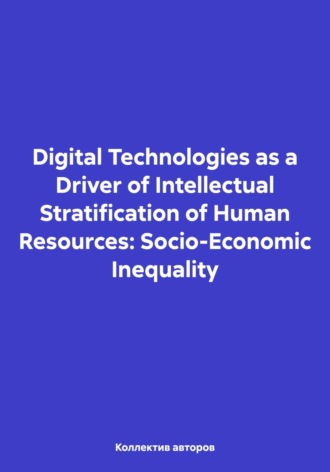
Олег Федорович Шахов
Digital Technologies as a Driver of Intellectual Stratification of Human Resources: Socio-Economic Inequality
II. LITERATURE REVIEW
The study of digital inequality is carried out by scientists all over the world: this issue is addressed not by just one organization. Well-known researchers, such as A.N. Semyonova, V.A. Stupkina [1], M. Rozin [2], T. Aleshkina, Yu. Yarosh [3], N. Albrekht [4], A. Balashova, R. Rozhkov [5], A. Belaichuk [6], D. Bulin [7] and many others, dedicate their work to this issue. Each of them considers IT as a driving force of the present, but at the same time, each one sees in this force a threat of increasing gap between technologically rich and technologically poor countries. Thus, according to the majority of researchers, the modern world is divided not ideologically but technologically. The higher the technological capacities of some countries, the more other countries lag behind them. To address the issue of digital inequality, a number of indicators were developed for an in-depth study of the problem. Such indicators differ depending on the researcher’s individual approach.
III. PROPOSED METHODOLOGY
A. Block Diagram
The phenomenon of the digital gap receives considerable attention from the world organizations, unions, integration associations (International Telecommunication Union, European Union and United Nations institutes). The basis of their actions on overcoming digital inequality is formed by the development of statistical reports, planning of programs for the elimination of technological backwardness of particular countries and regions and formulation of a number of proposals and recommendations concerning this problem. The experience in developing digital inequality calculation indexes is fairly common.
Fig. 1 illustrates Internet access in Russia in 2008–2018.

Fig. 1. Internet access in Russia in 2008-2018
B. Algorithm
This article uses the following methods: empirical, systematic, analytical, economic and other methods for the research of digital technologies as a driver of intellectual stratification of human resources.
IV. RESULT ANALYSIS
According to the indicators of development, in the modern global space, digital technologies represent a dynamic sphere. For instance, today, the number of mobile connections notably exceeds the number of people. Moreover, the number of people who can use a mobile phone exceeds the number of those who can satisfy their basic needs. In addition, the volume and direction of information flow in countries, their unions and continents are constantly growing, as a result of which the volume of such information in 2016–2018 accounted for more than one-third of the global GDP. These trends are especially impressive considering a certain slowdown in the growth of international trade in goods and services and the international movement of capital.
These circumstances affect the continuation of complications in the interaction of public institutes based on modern digital technologies both at the national and international levels. As a result, massive data flows become the basis for the formation and development of the digital economy, which is able to fully and effectively ensure production, processing, storage, transfer, use and protection of information. In particular, today, as argued by some researchers, in order to obtain an economic effect, it is important not only to have a certain resource but to have comprehensive data about this resource and the possibility to use them in the course of planning and decision-making [1].







